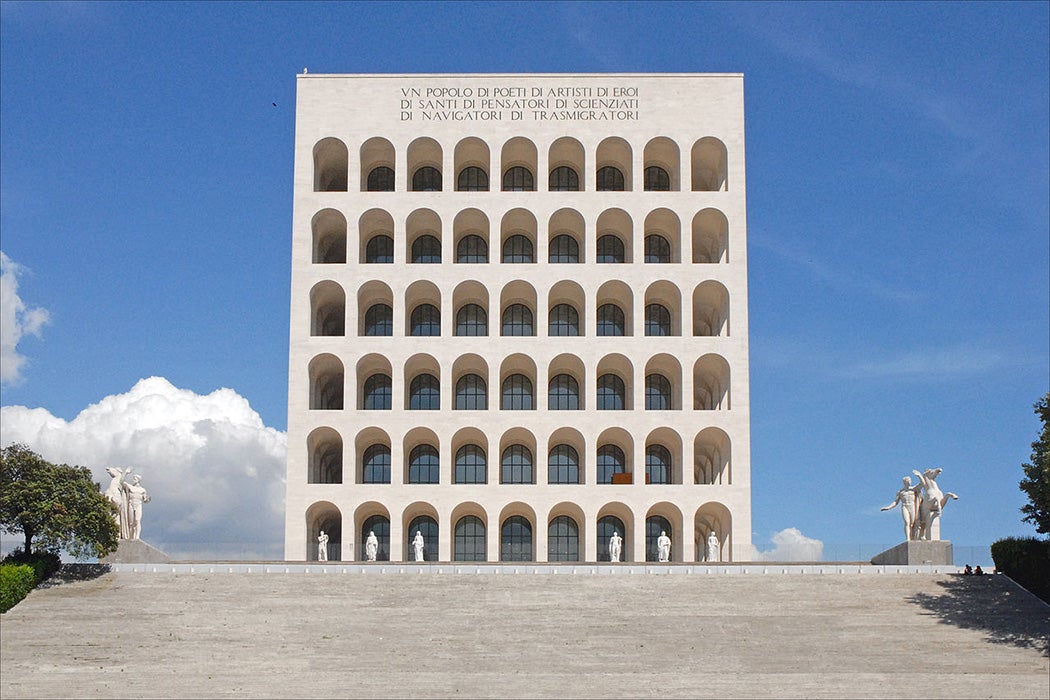As summer begins and travelers flock to Italy for a little taste of la dolce vita, many will discover that architecture is an essential part of the Italian experience. And Rome, Italy’s capital city with a history going back thousands of years, is a “must” for any Italian tour. Wandering through the Roman Forum or taking a tour of the Colosseum gives insight into the world of ancient Rome and its emperors. Popping over to Vatican City allows for marveling at St. Peter’s, an architectural example of power and awesomeness from the Baroque period. Yet one aspect of Italian architectural history probably not on the mind of the average tourist is the influence of Italy’s fascist period (1922–1945) on the built environment. Though hidden well within the historical layers of Rome, the lingering presence of totalitarian rule under Benito Mussolini, the National Fascist Party, and the Republican Fascist Party can still be found today.
The remnants of the era can be seen in both ancient monuments and new construction projects completed in Rome (and elsewhere) under Mussolini. The 1930s restoration of the (currently closed) Mausoleum of Augustus and the Ara Pacis Augustae [Altar of Augustan Peace] exemplify the role of fascist myth-making through romanità as it applied to the city. Romanità represented the “ideal of the ancient world, and particularly of ancient Rome,” and, as landscape architect and historian Franco Panzini reminds us, it “became the new nation’s constant point of reference.”
Benito Mussolini saw himself—and wanted others to see him—as the embodiment of a Roman emperor, and he sought to connect his rule as Il Duce with classical antiquity. To celebrate the 2,000-year anniversary of the birth of the first Roman emperor, Augustus, he approved the restoration of the Mausoleum of Augustus, which was then being used as a concert hall. At the same time, the Ara Pacis Augustae, an outdoor altar originally built during Augustus’ lifetime to celebrate his reign, was to be excavated and restored. According to historian Aristotle Kallis, “the anniversary of the emperor Augustus’ birth supplied invaluable opportunities for a symbolic interpenetration between (the Roman) past and (the fascist) present.” Both projects had roots in the nineteenth century, but the political potential of completing them within the year of the Augustan anniversary added urgency to the undertaking. Through the celebration of Augustus and the architectural campaign that supported it, Mussolini lay claim to the Roman emperor’s legacy.
New building projects required the fascist architectural agenda to balance history with modernism. While the valorizing of classical antiquity demanded an embrace of imperial Rome, Mussolini’s government was also intent on demonstrating its own modernity. As geographer John Angew writes, “Fascism vacillated between tying itself tightly to the past of ancient imperial Rome and eclectically building a new city on top and around the inherited one.”

The EUR neighborhood of Rome, which was designed for the never-held 1942 Esposizione Universale Roma, is a good example of this. The area’s most recognizable building, the Palazzo della Civiltà Italiana, is a modernist take on the Roman Colosseum. Designed by Giovanni Guerrini, Ernesto Bruno La Padula, and Mario Romano, the Palazzo stands as “a concrete sign in the Roman landscape, an architectural signifier for the polity that administered Italy and its inhabitants,” writes scholar Alberto Zambenedetti. With its simple rectangular form and lack of ornamentation—other than its repeating, stacked arcades that mimic the exterior of the Colosseum—the building blends modern architecture with the classical past. Today, the area has been developed into a business district, and the Palazzo della Civiltà Italiana serves as the new headquarters for Fendi, the Italian fashion house. An inscription from one of Mussolini’s speeches still stretches across the top floor of the building on all four sides, offering a hint of the area’s original purpose.
Despite the clear engagement with architecture by Mussolini and the National/Republican Fascist Party, it’s still easy to miss the fascist influence on urban development when visiting Rome. Why? Agnew argues that there are just too many layers to the city. “The city itself was a large part of the problem,” he writes.
So many “different” Romes were in play: classical Rome, Medieval Rome, Renaissance Rome, Baroque Rome, eighteenth-century Rome, pre-unification papal Rome, and post-unification Rome. Each of these was built on top of and often out of previous ones. Without a clean start by total demolition, the city’s very complexity of historical reference worked against a coherent reworking.
Rome had—has—too much history and too many identities to be defined by a single historical moment, even one help in a grip as firm as Mussolini’s. The fascist influence on Rome’s built environment is just one of the architectural histories to be uncovered in the Eternal City.







